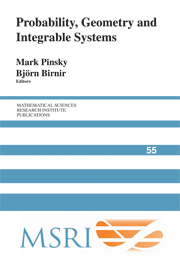Book contents
- Frontmatter
- Contents
- Preface
- Henry McKean: A tribute by the editors
- Bitangential direct and inverse problems for systems of differential equations
- Turbulence of a unidirectional flow
- Riemann–Hilbert problem in the inverse scattering for the Camassa–Holm equation on the line
- The Riccati map in random Schrödinger and random matrix theory
- SLE6and CLE6 from critical percolation
- Global optimization, the Gaussian ensemble, and universal ensemble equivalence
- Stochastic evolution of inviscid Burgers fluid
- A quick derivation of the loop equations for random matrices
- Singular solutions for geodesic flows of Vlasov moments
- Reality problems in the soliton theory
- Random walks and orthogonal polynomials: some challenges
- Integration of pair flows of the Camassa–Holm hierarchy
- Landen Survey
- Lines on abelian varieties
- Integrable models of waves in shallow water
- Nonintersecting Brownian motions, integrable systems and orthogonal polynomials
- Homogenization of random Hamilton–Jacobi–Bellman Equations
Integrable models of waves in shallow water
Published online by Cambridge University Press: 27 June 2025
- Frontmatter
- Contents
- Preface
- Henry McKean: A tribute by the editors
- Bitangential direct and inverse problems for systems of differential equations
- Turbulence of a unidirectional flow
- Riemann–Hilbert problem in the inverse scattering for the Camassa–Holm equation on the line
- The Riccati map in random Schrödinger and random matrix theory
- SLE6and CLE6 from critical percolation
- Global optimization, the Gaussian ensemble, and universal ensemble equivalence
- Stochastic evolution of inviscid Burgers fluid
- A quick derivation of the loop equations for random matrices
- Singular solutions for geodesic flows of Vlasov moments
- Reality problems in the soliton theory
- Random walks and orthogonal polynomials: some challenges
- Integration of pair flows of the Camassa–Holm hierarchy
- Landen Survey
- Lines on abelian varieties
- Integrable models of waves in shallow water
- Nonintersecting Brownian motions, integrable systems and orthogonal polynomials
- Homogenization of random Hamilton–Jacobi–Bellman Equations
Summary
Integrable partial differential equations have been studied because of their remarkable mathematical structure ever since they were discovered in the 1960s. Some of these equations were originally derived to describe approximately the evolution of water waves as they propagate in shallow water. This paper examines how well these integrable models describe actual waves in shallow water.
1. Introduction Zabusky and Kruskal [1965] introduced the concept of a soliton—a spatially localized solution of a nonlinear partial differential equation with the property that this solution always regains its initial shape and velocity after interacting with another localized disturbance. They were led to the concept of a soliton by their careful computational study of solutions of the Korteweg–de Vries (or KdV) equation, (See [Zabusky 2005] for his summary of this history.) After that breakthrough, they and their colleagues found that the KdV equation has many remarkable properties, including the property discovered by Gardner, Greene, Kruskal and Miura [Gardner et al. 1967]: the KdV equation can be solved exactly, as an initial-value problem, starting with arbitrary initial data in a suitable space. This discovery was revolutionary, and it drew the interest of many people. We note especially the work of Zakharov and Faddeev [1971], who showed that the KdV equation is a nontrivial example of an infinite-dimensional Hamiltonian system that is completely integrable. This means that under a canonical change of variables, the original problem can be written in terms of action-angle variables, in which the action variables are constants of the motion, while the angle variables evolve according to nearly trivial ordinary differential equations (ODEs).
Information
- Type
- Chapter
- Information
- Probability, Geometry and Integrable Systems , pp. 345 - 372Publisher: Cambridge University PressPrint publication year: 2008
Accessibility standard: Unknown
Why this information is here
This section outlines the accessibility features of this content - including support for screen readers, full keyboard navigation and high-contrast display options. This may not be relevant for you.Accessibility Information
- 1
- Cited by
